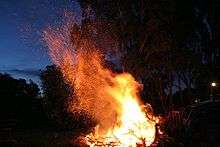Ember

An ember is a glowing, hot coal made of greatly heated wood, coal, or other carbon-based material that remain after, or sometimes precede, a fire. Embers can glow very hot, sometimes as hot as the fire which created them. They radiate a substantial amount of heat long after the fire has been extinguished, and if not taken care of properly can rekindle a fire that is thought to be completely extinguished and can pose a fire hazard. In order to avoid the danger of accidentally spreading a fire, many campers pour water on the embers or cover them in dirt. Alternatively, embers can be used to relight a fire after it has gone out without the need to rebuild the fire - In a conventional fireplace, a fire can easily be relit up to 12 hours after it goes out, provided that there is enough space for air to circulate between the embers and the introduced fuel.
They are often used for cooking, such as in charcoal barbecues. This is because embers radiate a more constant form of heat, as opposed to an open fire which is constantly changing along with the heat it radiates.
An ember is usually formed when a fire has only partially burnt a piece of fuel, and there is still usable chemical energy in that piece of fuel. Often this happens because the usable chemical energy is so deep into the center that air (specifically oxygen) does not reach it, therefore not causing combustion (carbon-based fuel + O2 → CO2 + H2O + C + other chemicals involved). It continues to stay hot and does not lose its thermal energy quickly because combustion is still happening at a low level. The small yellow, orange and red lights often seen among the embers are actually combustion. There just is not enough combustion happening at one time to create a flame. Once the embers are completely 'burned through', they are not carbon as is commonly believed (carbon burns, and is not normally left behind), but rather various other oxidized minerals like calcium and phosphorus. At that point they are normally called ashes. See: Wood ash for more on the residue that is left.
Embers play a large role in forest fires. Since embers are typically burnt leaves and thus small and lightweight, they can easily become airborne. During a large fire, with the right wind conditions, embers can be blown far ahead of the fire front, starting spot fires several kilometres away. A number of practical measures can be undertaken by homeowners to reduce the consequences of such an "ember attack" that bombards especially wooden structures and starts property fires.[1]
See also
- Spark, an airborne ember
References
- ↑ "Protect Your Property - Make your property safe from bushfire". Australian Country Fire Authority. Archived from the original on 2008-07-22. Retrieved 2008-07-25.
External links
| Look up ember in Wiktionary, the free dictionary. |
| Wikimedia Commons has media related to Embers. |
